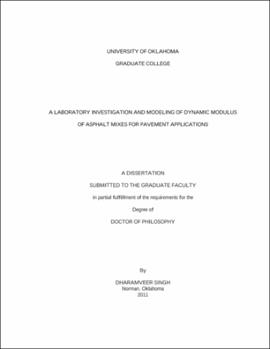| dc.contributor.advisor | Zaman, Dr. Musharraf||Commuri, Dr. Sesh | |
| dc.creator | Singh, Dharamveer | |
| dc.date.accessioned | 2019-04-27T21:29:17Z | |
| dc.date.available | 2019-04-27T21:29:17Z | |
| dc.date.issued | 2011 | |
| dc.identifier | 99230369302042 | |
| dc.identifier.uri | https://hdl.handle.net/11244/318807 | |
| dc.description.abstract | Traditionally, stiffness of hot mix asphalt (HMA) has been used as a measure of the pavement's ability to carry vehicular traffic loads without undergoing excessive deformation. Early deterioration of pavements due to rutting, fatigue cracking, and other type of distresses may be attributed to inadequate stiffness. The mechanistic empirical pavement design guide (MEPDG) emphasizes the use of dynamic modulus of asphalt mixes at all three levels of flexible pavement design. HMA mixes and aggregates that are commonly used in Oklahoma for the construction of flexible pavements were characterized in this study. | |
| dc.description.abstract | A database of dynamic modulus and master curves was developed for the mixes used in this study, which is expected to be useful in the implementation of the MEPDG for the design and analysis of flexible pavements. In addition, the effect of plant production and sample preparation methods on different aggregate shape parameters was evaluated. The results indicate that texture and form of coarse aggregates can change significantly during plant production and compaction in a gyratory compactor. No significant differences were observed for fine aggregates. The present study also compared the shape properties of three different types and sizes of coarse aggregates. The larger size aggregates were found to be rougher and more cubical compared to the smaller size aggregates, indicating that aggregate particles become smoother and elongated with a reduction in size. | |
| dc.description.abstract | Three different input levels of the MEPDG for modified and unmodified mixes were compared in this study. It was found that the accuracy of Level 2 and Level 3 depend on the mix type. The current study also evaluated the strengths and weaknesses of four empirical models (i.e., Witczak 1999, Witczak 2006, Hirsch, and Al-Khateeb) that are commonly used in estimating dynamic modulus. Analyses of the results show that the performance of a model varies with air voids and temperature. Statistical and neural network (NN) models were developed to estimate dynamic modulus including angularity, texture, form, and sphericity of aggregates as variables. Inclusion of shape parameters is found to enhance the predictive capability of a model significantly. It was found that the long-term oven (LTO) aging resulted in approximately a 42% to 60% increase in dynamic modulus, depending upon the amount of reclaimed asphalt pavement (RAP) in the mix and air voids. Overall, enhanced characterization of aggregates and asphalt mixes is found to be extremely important for pavement design applications. | |
| dc.format.extent | 316 pages | |
| dc.format.medium | application.pdf | |
| dc.language | en_US | |
| dc.relation.requires | Adobe Acrobat Reader | |
| dc.subject | Pavements, Asphalt | |
| dc.subject | Pavements--Testing | |
| dc.subject | Asphalt | |
| dc.subject | Asphalt emulsion mixtures | |
| dc.title | A LABORATORY INVESTIGATION AND MODELING OF DYNAMIC MODULUS OF ASPHALT MIXES FOR PAVEMENT APPLICATIONS | |
| dc.type | text | |
| dc.type | document | |
| dc.thesis.degree | Ph.D. | |
| ou.group | College of Engineering::School of Civil Engineering and Environmental Science | |
